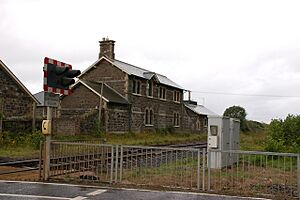Portstewart facts for kids
Quick facts for kids Portstewart
|
|
|---|---|
 |
|
| Population | 7,854 (2021) |
| District |
|
| County | |
| Country | Northern Ireland |
| Sovereign state | United Kingdom |
| Post town | PORTSTEWART |
| Postcode district | BT55 |
| Dialling code | 028 |
| Police | Northern Ireland |
| Fire | Northern Ireland |
| Ambulance | Northern Ireland |
| EU Parliament | Northern Ireland |
| UK Parliament |
|
| NI Assembly |
|
Portstewart (Irish: Port Stíobhaird) is a lovely seaside town in County Londonderry, Northern Ireland. About 7,854 people lived here in 2021. It's a popular seaside resort located close to Coleraine and Portrush. The town has a beautiful harbour and coastal paths. These paths lead to a two-mile long beach called Portstewart Strand. This beach is a favourite spot for families in summer and for surfers all year round.
Contents
About Portstewart
Portstewart has always been a popular holiday spot. Families from the Victorian times (a long time ago!) loved to visit. The town has a long, curved seafront promenade. This area is protected by rocky cliffs.
Portstewart is known as a well-off town. It is one of the nicer areas in Northern Ireland to live. Houses here have often been quite expensive. This shows how popular the town is.
People from different backgrounds generally get along well in Portstewart. The town has a mix of people from various Christian faiths. Dominican College, a Catholic grammar school, is one of the main schools here.
A Look Back: Portstewart's History
Portstewart was started in 1792 by John Cromie. He named it after his family, the Stewarts of Ballylesse. Before this, the area was called Port na Binne Uaine in Irish. This old name is still sometimes used today.
Long ago, in the Neolithic era, people lived here. But by the mid-1700s, Portstewart was mostly a small fishing village. It grew into a modest seaside resort in the mid-1800s. This happened thanks to a local landlord, John Cromie.
The town grew differently from its neighbour, Portrush. Portrush became very big with mass tourism. Portstewart kept a quieter, more gentle feel. A tram line was built to connect Portstewart to the railway. But the town still developed at a slower pace.
As cars became more common, Portstewart became a popular place for holidays and fun. Many people also moved here to live. This was because it was close to Coleraine.
From the 1950s to the 1980s, many new homes were built. This made Portstewart a residential area. It avoided the huge growth of caravan parks seen in Portrush.
In recent years, more students and people buying second homes have moved to Portstewart. This has changed the town's feel a bit.
Cool Places to See
- Portstewart has a Dominican convent. It's a grand Gothic building. Next to it is Dominican College. This school sits on a cliff edge. It overlooks the western end of the Promenade. The building was first built in 1834. The Dominican order bought it in 1917 for education.
- Just west of town is Portstewart Strand. This is a clean, two-mile-long Blue Flag beach. It means the beach is very clean and safe. The National Trust protects it.
- Below the convent, there's a cliff path. It goes along the coast from the Promenade to Portstewart Strand. From here, you can walk to the Barmouth. This is where the River Bann flows into the Atlantic Ocean. The path offers amazing views of the Strand and Downhill. You can even see Donegal in the distance.
- Portstewart Town Hall was finished in 1934. It's an important building in the town.
Getting Around Portstewart
Portstewart is close to the Portrush railway line. This line goes from Coleraine to Portrush. It opened in 1856. There used to be a station called Portstewart about a mile from the town. A tram connected the town to this station from 1882 to 1926. After the tram closed, the station didn't get many passengers. It closed in 1963. It briefly reopened as Cromore in 1969 but closed again in 1988. The old station building is now a private house.
Today, Portstewart doesn't have its own train station. The closest stations are Coleraine, University, Dhu Varren, and Portrush. Northern Ireland Railways connects these stations. You can travel west to Castlerock and Derry~Londonderry. You can also go east to Belfast Lanyon Place and Belfast Grand Central station. Ulsterbus provides bus connections to the trains at Coleraine station.
Sports and Fun
- Portstewart has three golf courses. They are all part of one club, the Portstewart Golf Club. The strong Atlantic wind makes playing golf here exciting! The championship Strand course is among huge sand dunes. It has amazing views across the mouth of Lough Foyle to the Inishowen peninsula. In 2017, the Strand Course hosted the Dubai Duty Free Irish Open. This was the biggest event ever in the town. It attracted over 92,000 people!
- Portstewart F.C. is the town's local football club. They play in the NIFL Premier Intermediate League.
- Every May, the North West 200 motorcycle race comes through Portstewart. The starting line and pit area are on the coastal road between Portrush and Portstewart. This race circuit is one of the fastest in the world. Bikes can go over 200 mph on public roads! It's one of the last big classic races in Europe. Over 150,000 people come to watch. It's the biggest outdoor sports event in Ireland.
- CLG Eoghan Rua, in Coleraine, is the local Gaelic Athletic Association club. Their playing fields are just outside Portstewart.
- Portstewart also hosts matches for the Super Cup NI. This is a famous youth football tournament.
Famous People from Portstewart
Many interesting people have connections to Portstewart:
- Field Marshal Sir George White (1835–1912) was a brave soldier. He was born nearby at Low Rock Castle.
- Jimmy Kennedy (1902–1984) was a songwriter. He wrote the famous song "Red Sails in the Sunset" after seeing a sunset here.
- Harry Gregg (1932–2020) was a famous Northern Ireland footballer. He used to own a hotel in the town.
- Henry McCullough (1943–2016) was a talented guitarist.
- Briana Corrigan (born 1965) was a singer for the band The Beautiful South. She grew up in Portstewart.
- Jimeoin (McKeown) (born 1966) is a well-known comedian.
Portstewart's Population
The latest count in 2021 showed 7,854 people living in Portstewart.
- Most people in Portstewart identify as Protestant or other Christian faiths (51.96%). About 35.13% are Catholic.
- Many people feel they have a British national identity (46.54%). A good number also feel they have a Northern Irish identity (40.21%). Some also feel they have an Irish identity (27.03%). People could choose more than one identity.
Schools in Portstewart
- Dominican College, Portstewart
- St. Colum's Primary School
- Portstewart Primary School
|
See also
 In Spanish: Portstewart para niños
In Spanish: Portstewart para niños







